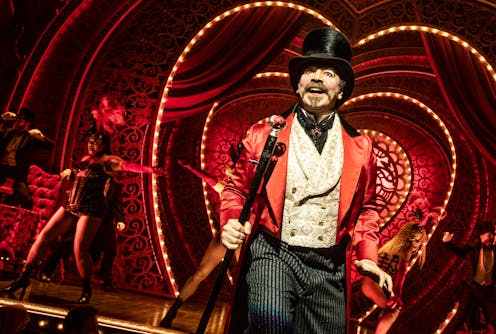 Come what may. Baz Luhrmann's Moulin Rouge was staged on Broadway this year and is headed for Australian stages. Supplied
Come what may. Baz Luhrmann's Moulin Rouge was staged on Broadway this year and is headed for Australian stages. SuppliedIn a 2004 original musical about creating an original musical – cheekily titled [title of show] – one writer asks, “So movies make good musicals?” His writing partner responds: “Well, they make musicals.”
This year, Australian theatre audiences have seen stage adaptations of the films School of Rock, Billy Elliot, Saturday Night Fever and Muriel’s Wedding. Tom Kitt and Lin-Manuel Miranda’s adaptation of Bring It On, based on the 2000 cheerleading movie, has already played in Melbourne and Perth and opened in Sydney last week.
In 2020, productions of Frozen, Waitress, Moulin Rouge and Shrek will be performed across Australia.
Bring It On brings good cheer and audiences to the theatre.Some original imports like Come From Away and The Book of Mormon are being seen on Australian stages and Hamilton will open here next year, but the emphasis on movie adaptation seems to have a limiting effect on original Australian creation.
Recent announcements by the Queensland Theatre Company, Melbourne Theatre Company and Belvoir St Theatre do not include plans to premiere new Australian musicals in 2020.
From novel to screen to stage
Musical theatre has always been a genre that favours adaptation. In 1927, Show Boat was an adaptation of Edna Ferber’s novel. Oklahoma was based on the play Green Grow The Lilacs by Lynn Riggs. Musicals were adapted from novels, plays, short stories (South Pacific, Guys and Dolls), comics (Annie, You’re A Good Man Charlie Brown) and even the Bible (Godspell, Jesus Christ Superstar).
When Oscar Hammerstein II mentored Stephen Sondheim as a composer and lyricist, he set him the task to write four musicals, including three adaptations.
As cinema increased in popularity, musicals were increasingly based on movies. These ranged from arthouse films such as Fellini’s 8 ½ (adapted as Maury Yeston’s Nine) and Ingmar Bergman’s Smiles of A Summer Night (Stephen Sondheim’s inspiration for A Little Night Music) to blockbusters such as Sister Act.
Of course, this process can also be reversed with movie musicals like the upcoming Cats starting life onstage. The cycle completes itself when a production like Hairspray goes from screen to stage and is then filmed as a movie musical.
Adapting popular films for the stage became common practice in the 21st century as producers sought to draw new audiences into theatres to see shows with familiar titles. The most recent Broadway season included adaptations of Pretty Woman, Tootsie and Beetlejuice.
Many ways to stage
The most straightforward adaptation approach is to use songs from the soundtrack of an original movie to create a jukebox-style experience. Moulin Rouge is an example of this style of adaptation, along with Priscilla Queen of the Desert. Although the music rarely propels the plot, the songs provide spectacular entertainment.
Other adaptations, such as School of Rock, Kinky Boots and Pretty Woman take an existing plot and insert original songs, usually by one composer (Andrew Lloyd Webber for School of Rock, Cyndi Lauper for Kinky Boots and Bryan Adams for Pretty Woman). Songs are used to create memorable production numbers, but also take the place of dialogue or provide a reflective solo number.
One difficulty with this style of adaptation, though, is that audiences are not familiar with the new songs and often expect to hear music from the original movie. The Roy Orbison song Oh Pretty Woman was not originally included in the Broadway production of Pretty Woman but was later added to the finale for this reason.
Disney’s stage adaptations (Beauty and the Beast, The Lion King) tend to be a hybrid of these two approaches, incorporating the well-loved songs from the movie and adding new songs by the same composer.
Disney favourite Frozen has been adapted on Broadway.Bring on originality
Some of the most successful film adaptations bring new elements to create a stage version with enough familiarity to appeal to the audience while also updating the setting or altering the plot to spark new moments of engagement.
Muriel’s Wedding still tells the familiar story of awkward Muriel Heslop but contemporises the original film by incorporating the pressures of social media in the song Shared, Viral, Linked, Liked.
Bring It On maintains the thrilling cheerleading elements of the movie, but incorporates issues of self-esteem, socio-economics and the LGBTQ community.
Australian musicals such as Hot Shoe Shuffle (1992), The Boy From Oz (1998) and Keating! The Musical (2005) have proved successful in the past. Since 2017, Muriel’s Wedding has toured nationally and Barbara and the Camp Dogs trimphed at the Helpmann Awards.
But other than a revival of Bran Nu Dae our stages will be bereft of original Australian musicals next year. This may reflect an influx of international productions and low risk scheduling.
Adaptation is an important element of musical theatre, which can harness the power of a well-known property for the stage and draw new audiences to the theatre. While film adaptations are sometimes critiqued as shameless attempts to play on nostalgia to chase dollars, they can also produce satisfying theatrical pieces that develop the artform.
Hopefully, those new audiences will eventually encourage Australian producers to develop original works as well.
Trevor Jones does not work for, consult, own shares in or receive funding from any company or organisation that would benefit from this article, and has disclosed no relevant affiliations beyond their academic appointment.
Authors: Trevor Jones, Lecturer in Musical Theatre, Griffith University
Read more http://theconversation.com/hollywood-onstage-why-are-so-many-musicals-adapted-from-movies-122329
| < Prev | Next > |
|---|








